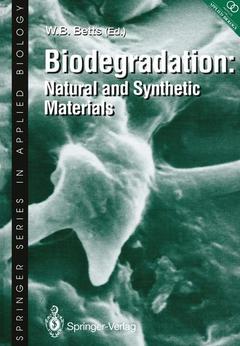Biodegradation, Softcover reprint of the original 1st ed. 1991 Natural and Synthetic Materials Springer Series in Applied Biology Series
Langue : Anglais
Coordonnateur : Betts W.B.

Two major problems encountered as we approach a new century are the availability of resources for chemicals and energy, and environmental pollution. This book highlights the importance of biotransformation as a solution to these problems and considers traditionally separate areas as one interdependent discipline, in terms of the underlying mechanistic biochemistry and the research techniques employed. The provision of resources has largely centred around non-renewable materials, especially oil. Diminishing reserves of these, together with uncertainties of supply and cost have stimulated great interest in renewable resources. These are largely lignocellulosic materials (e.g. wood and straw) which are available through natural biomass turnover, farming and forestry and from wastes generated by industrial processes. An excellent example is that of kraft lignin, a by-product of pulp and paper production, amounting to 60 million tonnes per annum and which is largely wasted by burning or landfilling. This aromatic polymer has enormous potential as a feedstock to the chemical industry. Environmental pollution is no longer accepted as inevitable for a technological society. Over the past decade there has been a tremendous increase in awareness of the effects of pollution and public pressure has influenced both industry and government. However, to be realistic, it is not possible to replace all processes generating polluting wastes with clean alternatives. Instead, treatments of pollution, both at source and after an incident, are alternatives in many instances and a great deal of emphasis is currently being placed on these.
1 Aspects of the Aerobic Degradation of Aromatics by Microorganisms.- 2 Degradation of Haloaromatic Compounds.- 3 Biodeterioration of Fuels.- 4 Biodegradation of Nitriles and Cyanide.- 5 The Fate of Chemicals in Soil.- 6 The Effects of Sorption on the Bioavailability of Pesticides.- 7 Biosynthesis and Structure of Lignocellulose.- 8 White-Rot Degradation of Lignin and Xenobiotics.- 9 Enzymes of Lignin Degradation.- 10 Actinomycete Enzymes and Activities Involved in Straw Saccharification.- 11 Uses and Potential of Lignocellulose.- 12 Commercial Aspects of Bioconversion Technology.
Date de parution : 05-2012
Ouvrage de 238 p.
17x24.4 cm
Disponible chez l'éditeur (délai d'approvisionnement : 15 jours).
Prix indicatif 105,49 €
Ajouter au panierThèmes de Biodegradation :
Mots-clés :
energy; environment; environmental pollution; enzymes; microorganism; pesticides; pollution; soil
© 2024 LAVOISIER S.A.S.



